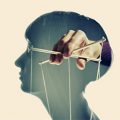
Treating OCD effectively is freeing someone from endless, agonising toil.
“I’m possessed by a slave driving, merciless, control freak devil!”
That’s how Susan described Obsessive Compulsive Disorder (OCD) when she came to me for treatment.
It was the first time I’d heard it described quite so evocatively, but I’d treated enough cases to know she wasn’t just trying to be dramatic.
OCD can manifest in many different ways, but there are always a few things in common: dark circles under the eyes, slumping shoulders, and a sense of defeat. They’re enslaved to the unrelenting tyrant that is OCD.
Prefer to watch instead?
OCD can present as:
- Persistent thoughts or feelings, images in the mind, or even imagined sounds
- A forceful need to perform rituals, such as checking or washing, in an attempt to subdue the obsessive feelings or avert some imagined disaster
- Continual doubt over important or even minor matters, a sense of anxious questioning in the mind, and an ongoing search for reassurance and relief from the anxiety.
Just as with some addictions, there seems to be an element of habituation with OCD in that more and more checking or cleaning is required to get the same reassurance ‘hit’ – meaning more and more time is spent serving OCD’s unreasonable demands.
And OCD thrives on stress, which is why it will often begin during academic test times or during a difficult life period. But why do some people develop OCD during stressful periods and others not?
Where does this overblown need for control come from?
We all need to feel some control in our lives. Having a sense of influence is important for us all, but for some people, that need for control is really important. Sometimes this pattern of thinking can emerge in people with perfectionistic tendencies. There is a kind of ‘magical thinking’ inherent within OCD: “I can avert some disaster [and control reality] if I count to one thousand or wash my hands 500 times!”
Some OCD sufferers come from very powerless childhoods, in which inner control was a substitute for such miniscule outer control.
One man, Keith, told me how his parents had severely abused him, both physically and mentally, no matter how he behaved or communicated with them. He felt totally powerless. But at night he would walk around his bed 50 times before getting into it. He felt that somehow this would make his parents less angry with him and, in that way, he clawed back some sense of control.
So perfectionism or an amplified need to feel in control, safe, and secure really drives OCD. This need may have arisen from times of stress in which the OCD sufferer felt little or no control over events and situations. But there is another element to OCD.
Why OCD is like a dream (or a nightmare)
OCD is driven by stress, but it is also trance-like. OCD clients often talk of being “tranced out” and totally focused on their obsessive thoughts, feelings, and rituals, to the point where the outside world and other concerns just fade away.
Therapeutic hypnosis often creates a sense of time distortion, with clients feeling quite unaware of the length of time they’ve spent in hypnotic trance. Sometimes afterwards they have some amnesia for the hypnotic experience, or it seems hazy to recollect – at least consciously.
In naturally occurring but counterproductive trance states such as OCD, you often find these same hypnotic elements. Someone with OCD may experience amnesia for the experience of checking or washing and forget they actually have checked or washed.
It’s because of this naturally occurring hypnotic element to OCD that therapists increasingly use hypnotic techniques to treat it.
Therapists talk about treating OCD
We recently had a Q&A session for practitioners taking our Precision Hypnosis course, and I wanted to share one particular question and answer with you all, because I think it sheds valuable light on treating OCD. You can read my answer, as well as my colleague Joe Kao’s, below. Or of you prefer, you can listen to the audio at the bottom of this article.
Question from practitioner Mark Marsland:
“She’s the first OCD client that I’ve worked with. I used the Rewind Technique on her, which I’ve used to great success since I trained with you guys using it. I’ve already spoken to Mark about this. We had a really good chat about one particular session where I had great success with a client.
This girl has come in and she’s excessively wringing her hands. She’s thinking about bad thoughts all the time and perpetually going over things, almost like she’s slipping into a hypnotic trance and is unaware of time and space when this happens, and it sort of happens automatically.
She’d originally been in a biology lesson at school, and two guys had come in with one of these UV lights and were talking about germs.
They were showing her the germs on her hands, on her desk, on her friend’s clothes, on the door knobs, everywhere. Really drilling it into them how important it was to wash your hands and to wash surfaces and to wash your hands before you eat or before you touch food, and then after.
This obviously sank deep into her subconscious mind and she took it on board literally. From there on, the problem started to develop.
I took her back. I asked her where she was. Just talking about it, just touching on that memory. She was a seven or an eight. I could see her colouring up a little bit and fidgeting and actually starting to wring her hands, as if she was mentally, or subconsciously I should say, playing it out.
We used the Rewind Technique, found her special place. She loves dancing so I put her into dancing school where she was smiling and dancing and happy and pattern matching that to this incident and obviously doing the double dissociation and everything without going into too much detail.
She was instantly much better. This was on Friday. She had a great weekend apart from the fact that at the end, later on the Sunday, Dad was having a bit of an argument with Mum about inviting some friends round and Dad said, ‘You’re a long time dead.’ The girl took this literally and started to think about death again.
Although she was better, the thoughts came over.
My question was, when you’re working with people with OCD, what have been your experiences? What have you found works and how can you help me to be a better, more accomplished therapist when I’m working with a client or clients with OCD?”
Mark Tyrrell’s answer:
“It sounds like you’ve done some good stuff with her already.
One thing I always do with obsessionality is to normalize it. People feel weird for having weird thoughts, but actually anyone with any imagination at some point has had a weird thought. Sometimes it’s prompted by fear or anxiety, or boredom even, which is a form of stress of course. Some weird thought might come into your head.
The mistake that people then make is to assume that they must be weird for having this weird thought. Maybe people who are not suicidal imagine hurling themselves off a building or attacking somebody or doing something that they would never, ever, ever do, but because it’s the worst thing they could possibly imagine, then it scares them.
I’ll often talk in terms of free floating anxiety needing a shape and a form. Like water will find a channel to fill to give the water shape, so too will free-floating anxiety if it’s not focused on something real.
If the person for whatever reason feels stressed and anxious and perturbed, then if nothing is going on in the environment right now that is threatening, if they have a good imagination, but they’re using it badly, they will spontaneously form a shape for the anxiety to fill, because anxiety doesn’t like a vacuum.
It could be that they’ve said something terrible to someone, that they’ve done something.
I worked with a nurse who would come home from work and be terrified she’d made a mistake at work that had led to the death of a patient, that somehow she’d given them the wrong drugs or whatever it was. She was a very meticulous person. That would obsess her.
Another guy would have to walk back the way he’d driven back from work because he thought maybe he’d run over somebody. He’d watch the news even though he wasn’t aware of that happening. People with those types of obsessive thoughts often don’t trust their own perception and their imagination takes over.
We can frame it as imagination and we can talk in terms of, ‘You can think anything, but you don’t have to buy into it.’
Stephen King imagines all kinds of stuff, or other horror writers, Frank Herbert, or someone like that. They make a living out of using their imagination in horrifying ways.
But they don’t necessarily buy into their own imaginings like someone who is suffering from their own imagination does. They can learn to separate from it and not buy into it. You can imagine anything whilst feeling very relaxed.
One thing I’ll often say to someone is, ‘I could imagine a meteorite coming in right now into this room. I could imagine that whilst totally relaxed.’ Actually using the imagination and the emotions, you can disentangle the two. This is an idea that I might present to somebody in that way.
And certainly using the Rewind as you have done for specific memories and that kind of thing.
Another thing I’ll sometimes do with somebody is, I’ll talk about the imagination and I’ll say, ‘Now what I want you to do is to close your eyes and when I clap my hands, I want you to open your eyes.’ I clap my hands and they open their eyes.
‘Then I want you to imagine me clapping my hands, and if you think that was real, then you open your eyes.’ Of course, they don’t open them.
You’re training them to really become confident about distinguishing between reality and imagination.
That’s a very simple technique, but it can give people a real sense of confidence because they reach a pitch where they so don’t trust their reality filters or perceptions over their imagination.
That’s really the difference. Someone doesn’t trust the fact that they’ve switched the tap off, so they have to check 100 times, and so on. There’s a couple of ideas.”
Joe Kao’s answer:
“Just a few other things that came to mind as Mark was talking there.
With OCD, there’s the issue of working with the pattern, with the behaviour itself. Then there’s also other basic needs, the Primal needs, emotional needs that the person is not meeting in their life.
OCD certainly can be triggered by a single event, like the girl when the people came in with the UV light. It’s like the men in black coming in The X-Files and showing you the germs that can be everywhere.
There are principles of working with clients that are true for nearly all clients, or certainly clients suffering from anxiety, from depression, where whatever the particular pattern is, it’s always going to be good for them to be working towards meeting their needs for social contact, for having a place where they can feel safe, where they can feel secure, having things that creatively engage them.
All the standard principles of working with people in a solution-focused way apply.
Then when you narrow down and work specifically on the pattern of OCD, something I very often use is externalizing it, separating it from the client, or talking about how it’s trying to get you to engage in that ritual. It’s trying to get you to do that.
The question is how you can free yourself from that OCD pattern. It tries to take over more and more. It tries to get you to anxiously wash your hands. Then it tries to get you to compulsively clean this and that.
I don’t just do that once in a session. I’ll do that repeatedly over multiple sessions, talking about it as an ‘it’, and how we can beat it.
Then also doing calm dissociated future rehearsal of not doing the ritual because the ritual itself very much resembles all kinds of superstitions; ‘I’m trying to avoid something bad happening,’ even though, sometimes the person doesn’t even know what that thing is that they’re trying to avoid happening.
If they’re washing their hands, yes they’re trying to avoid contamination. If they’re checking that the gas is turned off, they’re trying to avoid their house exploding.
But when it gets to things like turning the lights on and off, on and off, on and off, it shows you the true face of OCD: that it is just this abstract superstitious pattern that’s trying to make you believe that something bad is going to happen if you don’t engage with it.
Being able to calm down the felt sense of what it’s like to be not doing that ritual, what it’s like to deliberately be not doing it, and to feel calm as you do so. That’s a big part of the hypnosis work that I do with people.
And then tasking as well; getting them, for example, to do the same ritual, but whenever they do it, to do it at half speed.
If you’re going to wash your hands, slow right down as you do it and really become lusciously aware of the soap and just slow it down. Even do it at a quarter speed.
Principles like that are varying the pattern. It makes it hard to be such a compulsive event. Really getting them to buy into and to commit to that kind of task for the next week. Whenever you wash your hands, if you’re going to do it, slow right down.”
Mark’s reply:
“That’s lovely Joe. Teaching them to stay out of trance or come out of trance during the OCD activity, the obsessive activity. Because, as you quite rightly say Mark [Marsland] it is a trance-like activity.
The person often loses the sense of time and space and so forth, and becomes absolutely absorbed in what they’re doing. They don’t realize that three hours have gone by, or whatever it is.
It’s about teaching them to stay out of it, to do it differently.
Or, giving someone the obsessive behaviour as a chore in a paradoxical intervention can then build up a reluctance in the person.
Now the person is told to do it, they have to do it. It’s often a rebellion that will be harder for them to do. They just won’t get the same out of it and so forth, as Joe was saying.
So tasking can be important as well with OCD.”
And you can listen to the audio from this Q&A excerpt here:









